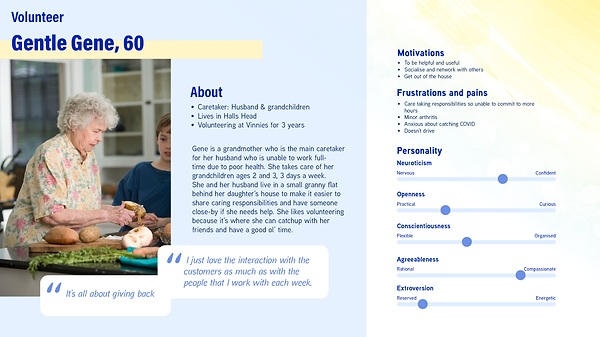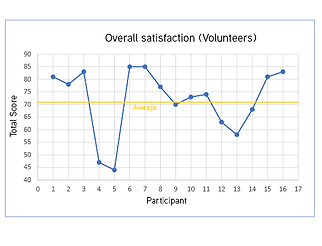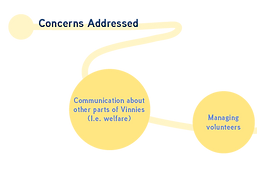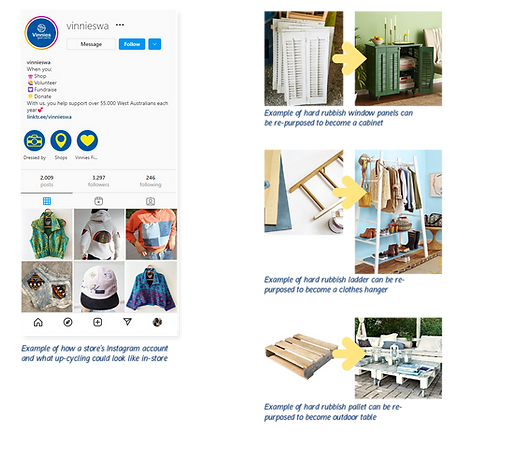
How might we provide a better experience for volunteers and managers in our retail stores and increase funding to other support services?
St Vincent de Paul Society (Vinnies)
Vinnies is a non-for-profit organisation who's mission is to help people in need and provide services that will really make a difference to their lives. Their retail stores are the fundamental source of funding for their organisation, the profits gained from these stores are used to support other programs and provide aid to those in need. It is crucial for Vinnies as a organisation to ensure that their stores are successful and meeting their objectives to support other Vinnies operations and community services.
Team
Harness Projects
Type
Service
Role
UX Researcher/ Service Designer
Skills
Research Summary
This research seeks to understand the experiences of the volunteers and retail managers in store, not only to further enhance their experiences but to enable Vinnies to increase their revenue.
The key themes identified from the research involved issues with communication, company structure and process, management style and in-store operations.
Although Vinnies stores operate using a retail structure to capture revenue, it needs to consider the differences in operating mainstream retail stores from a retail store for a charity organisation. Vinnies staff whether they are volunteers or managers work because they are motivated by their compassion in helping people, however these attitudes shouldn't be taken for granted and more effort needs to be demonstrated to show their appreciation.
The organisation consists of dedicated people that believe what they do makes a difference, actively engaging with them and understanding from their perspectives will enhance their experience and ensue an uplift to store operations.
Research Process
Define
Understanding the brief
The Harness Project team conducted a stakeholder interview with the Vinnies representative to gather further background information and breakdown the brief. The information gathered was used to form the survey questions and was a basis for the interviews.

Objectives
Business Objectives
-
To increase overall employee satisfaction
-
To understand why volunteer attitudes (thinking/feeling) don’t align with their behaviours (what they say and do)
-
To increase retention of volunteers
-
To increase revenue in retail stores
Research Objectives
-
Understand the motivations and goals of volunteers at retail stores
-
Define the frustrations experienced in retail store operations from both volunteer and manager perspectives
-
Understand the attitudes towards Vinnies as an organisation
-
Understand how sales targets affect motivation and in-store operations
-
Understand the issues that cause volunteers to leave
Hypothesis
Satisfaction
-
Redefining a manager’s responsibilities and redistributing their workload will have an overall positive effect on the store culture and its employees
-
A manager’s job satisfaction will be increased if managers are able to see improvements to the communication and feedback loop.
Retention
-
Initiatives that encouraged volunteers to broaden their existing knowledge and learn new skills would motivate volunteers to stay longer
-
A fun, sociable and thriving culture with a diverse demographic at Vinnies can build lasting connections and motivate volunteers to stay longer
Revenue
-
Revenue can be increased if they look beyond donations as a single source of funding
-
Utilising current retail trends will attract a new target market and enable recruitment of a new cohort of volunteers
Research
Recruitment
Recruitment for this project was primarily sourced from Vinnies current data base of employees and volunteers. This list doesn’t include anyone that is no longer working with Vinnies.
Interviews
1:1 interviews were conducted as a team with Harness Projects to ensure enough breadth of participants were covered, where I personally interviewed 2 managers and 2 volunteers.
The analysis of this research report contains information gathered from:
-
4 interviews with managers
-
3 interviews with volunteers
-
1 interview with a volunteer from Victoria
Surveys
The surveys were extended to all volunteers and managers within the WA region. Within an approximate 2 week period, we received 11 responses from managers and 16 responses from volunteers.
Research Limitations
-
The research study was conducted within a short time period (2 weeks), whereby the sample size gathered can’t be considered to represent all opinions.
-
The survey was limited to people that currently volunteer and don’t capture attitudes and opinions from people who no longer work for Vinnies.
-
The data has been reviewed relative to the sample size only.
-
The sample size was limited to those that willingly responded to the survey, inherently capturing a demographic that is either very satisfied or very dissatisfied, polar opposite sides of the scale.
-
The report analysis only reviews the information provided by Vinnies representative, publicly accessed information on the web and the data gained from the surveys and 1:1 interviews.
-
The recommendations are limited in scope and detail and are based on the information uncovered in the surveys, interviews and client briefing session.
Synthesis
Personas/ Empathy mapping




Personas and empathy maps were created based on user interviews and the responses to the survey questions.
Combination of personas and empathy maps provided good insight to the people we were researching.
Survey outcomes
As overall survey results were highly rated qualitatively, a quantitative approach was used to extract more in-depth data to review.
Survey questions were asked across 5 categories: About, Onboarding/training-development, Role, Feedback culture and engagement, Referrals.
The data from the survey was isolated to only show the numerical values for the questions where participants had to provide a rating from a scale of 1 to 5.
1 = Very Dissatisfied
2 = Dissatisfied
3 = Neutral
4 = Satisfied
5 = Very Satisfied
Volunteers
Survey responses show that participants are satisfied across all categories except the organisation, company structure (Q16-Q19) and culture (Q23).


Managers
Survey responses show that participants are least satisfied with their salary, workload, organisation and company structure.


Affinity mapping
Card sorting revealed many interconnected themes.

Solution
Recommendations

Engagement
Create a system where retail managers are part of the stakeholder group that is engaged in the decision making process for policies and initiatives that affect their operations in retail stores.
Retail managers can be engaged as part of the initial consultation process in early stage development or as part of a working group that is continually reviewing the processes and providing feedback from the operations perspective to evaluate the effective of new policies.


Process
Review and update the retail store grading system guidelines to benefit all stores not just the designated ‘A’ grade stores.
Instead of redirecting all ‘retro’ styled clothes and branded clothing to just the retro boutiques, change the distribution quantities to allow quality/branded stock to also be sold at B and C grade stores.
Having a small percentage of good quality stock that these stores can sell at a higher price will ensure all stores are more equitable and allow them to attract the type of buyers that will spend a little more in-store.


Recruitment
Expand the volunteer recruitment marketing campaign to appeal to people that have flexible schedules such as university students and working professionals who either don’t work full-time or are able to determine their own schedule.
People have a misconception that they don’t have time to volunteer, even if they are motivated to do so, they are hindered by the verdict “I’m too busy” and don’t make it a priority. If it can be demonstrated that a shift can fit seamlessly into their own lifestyle, it would make it easier for them to consider volunteering.


Affiliations
As a non-for-profit organisation, Vinnies retail stores are often misunderstood to be a centre that offers emergency assistance. With limited resources to connect to other services offered at Vinnies, retail managers aren’t able to provide necessary help to people that request it in-store.
Affiliations and partnerships with local businesses in the area that offer either food, aid, or housing can be used to offer temporary help to those that need emergency assistance. After which Vinnies support services can followup and provide a more permanent help service.


Appreciation
More appreciation can be shown to volunteers by organising more social events/get togethers for volunteers at each store rather than having a large event for all volunteers across the WA region.
This will enable volunteers on different days to get to know each other and foster a stronger connection within their immediate store. Affiliations with local businesses can help keep costs down.


Communication
In-store communications can be used to boost volunteer awareness and keep them updated on the good acts that other services across Vinnies are engaged in.
This can be a simple dashboard notice issued out to the retail manager who can print it out and leave in the breakroom/noticeboard for volunteers to physically read when they come into the store. The dashboard notice can be issued out monthly to keep the topics interesting and progressive.

New Roles
Develop new roles and responsibilities that compliment retail operations and appeal to people with different interests and skill sets.

Specific Instagram accounts for individual stores:
Retail trends are moving into the online space and selling through digital channels, there is opportunity to increase revenue and appeal to a younger demographic who are tech savvy

Up-cycling scheme (Garments and clothing attire):
Appeal to people that have sewings skills or upcoming fashion design students that want to utilise their skills in design and re-purposing material

Up-cycling scheme (Furniture and hard waste):
Appeal to people have interests in carpentry, who like to use their tools to fix and re-purpose furniture. A workshop can be based at the depot for volunteers to sort and re-purpose, these pieces can then be sold in-store or online
Examples

What did I learn from this experience?
1 /
The research process is dynamic, it evolves with each encounter.
2 /
By comparing how people do things to what they say they do, it provides deeper insights into the "whys" and motivations of a person.
3 /
Quantitative data is a good source to provide support to qualitative data however isn't as insightful by itself.
